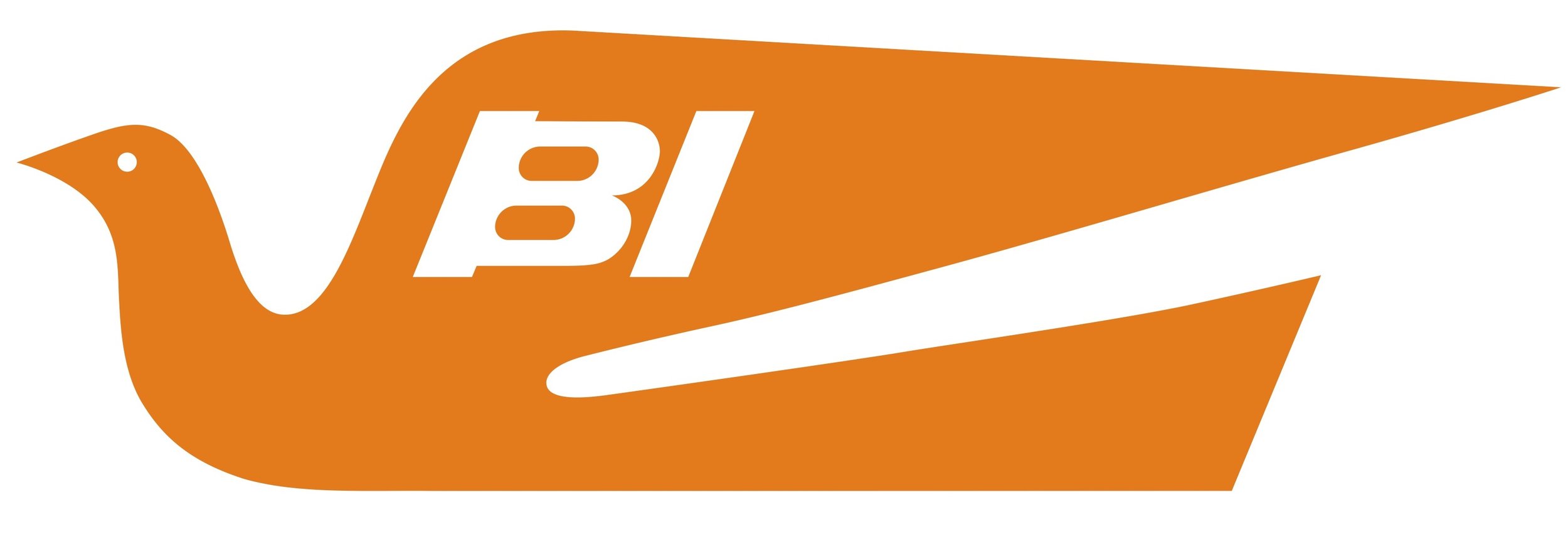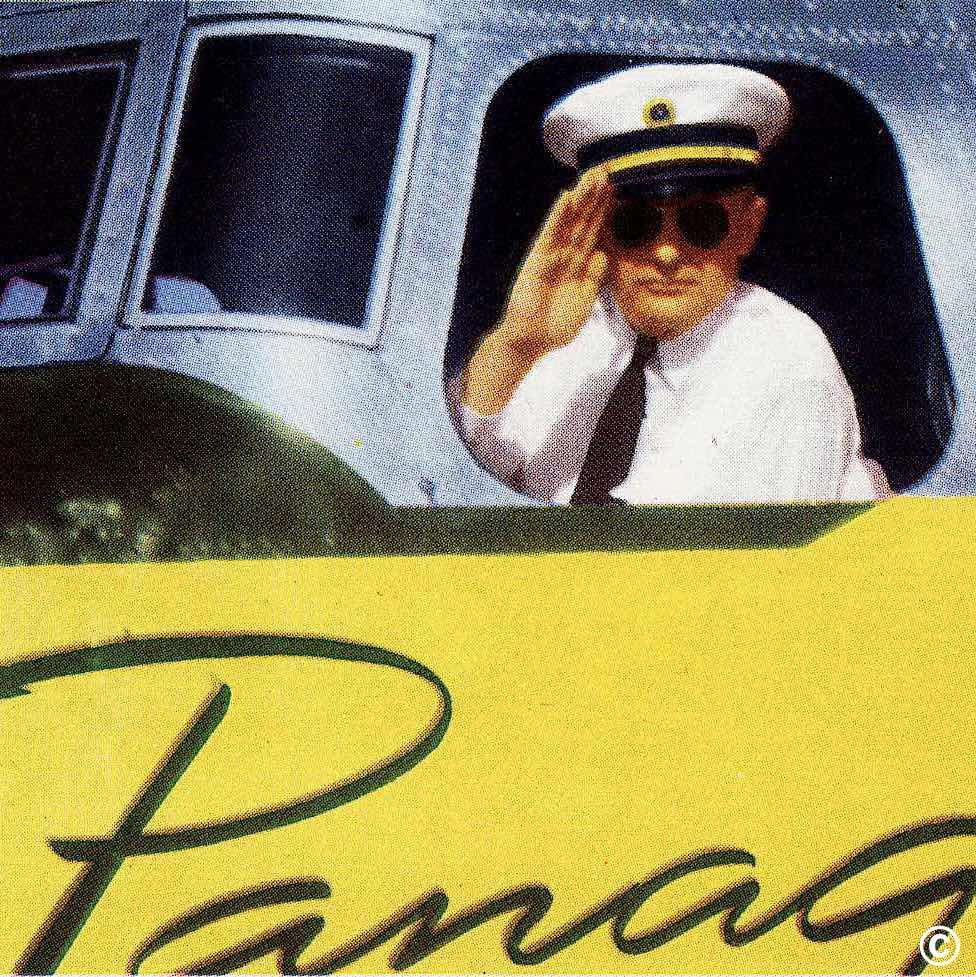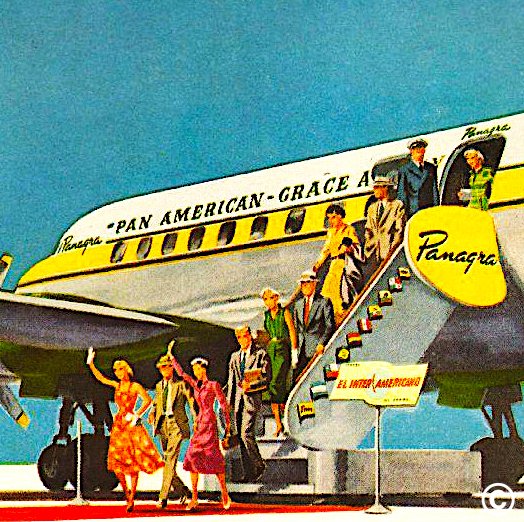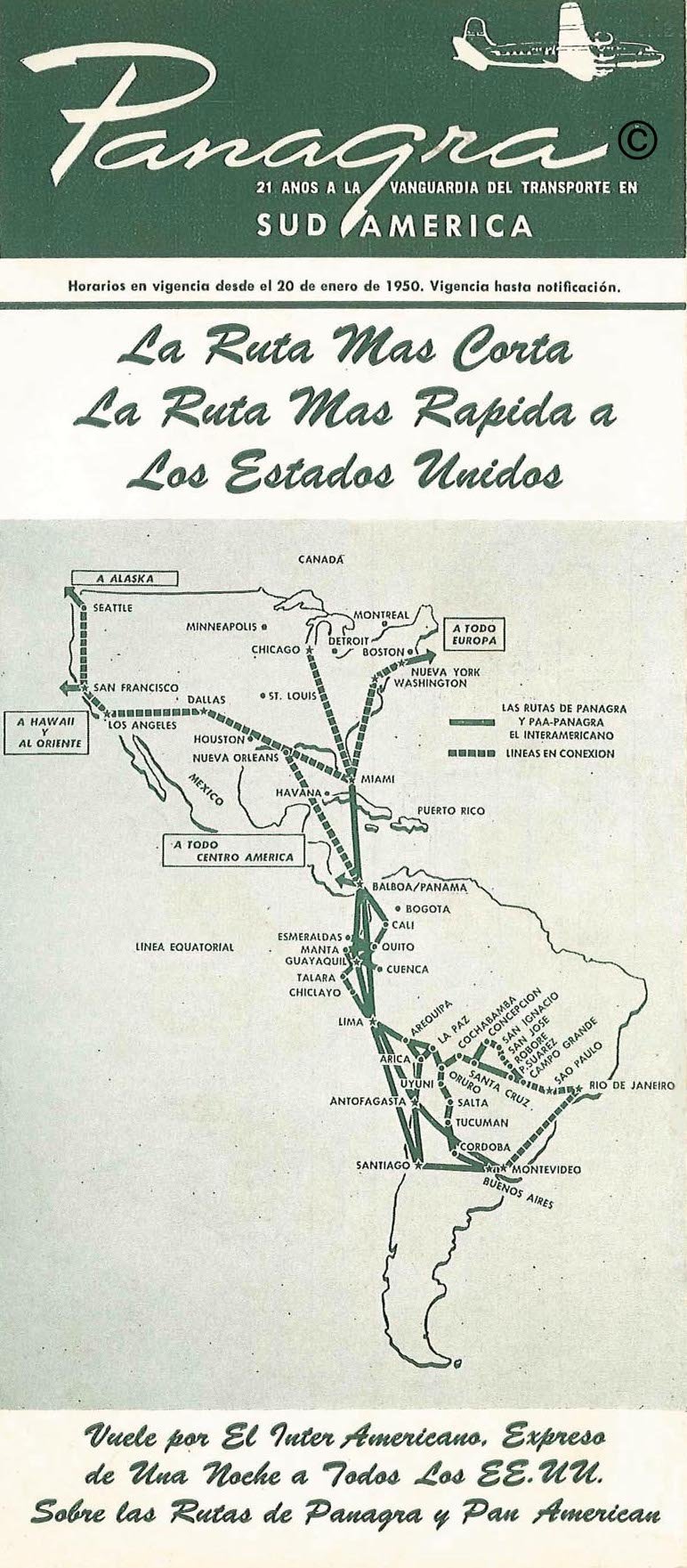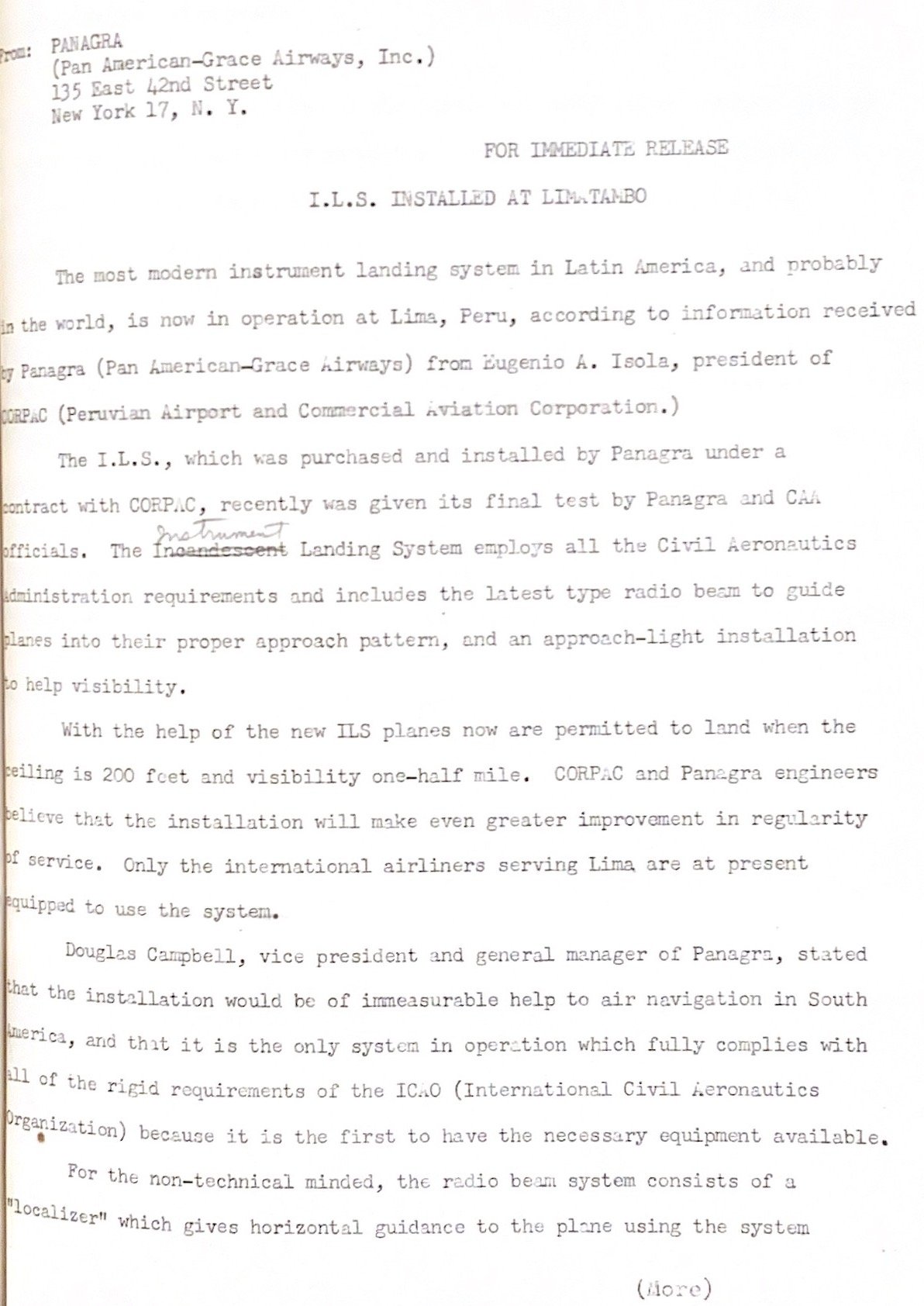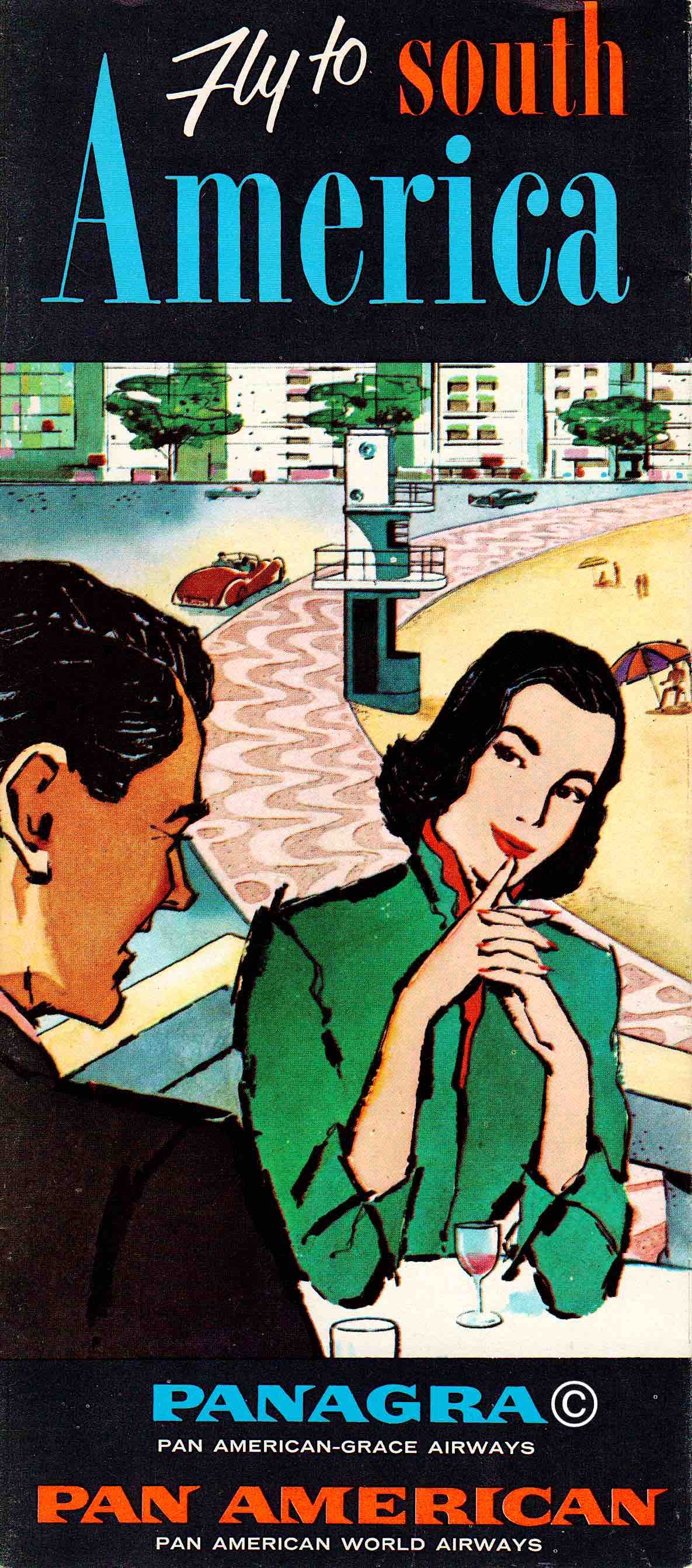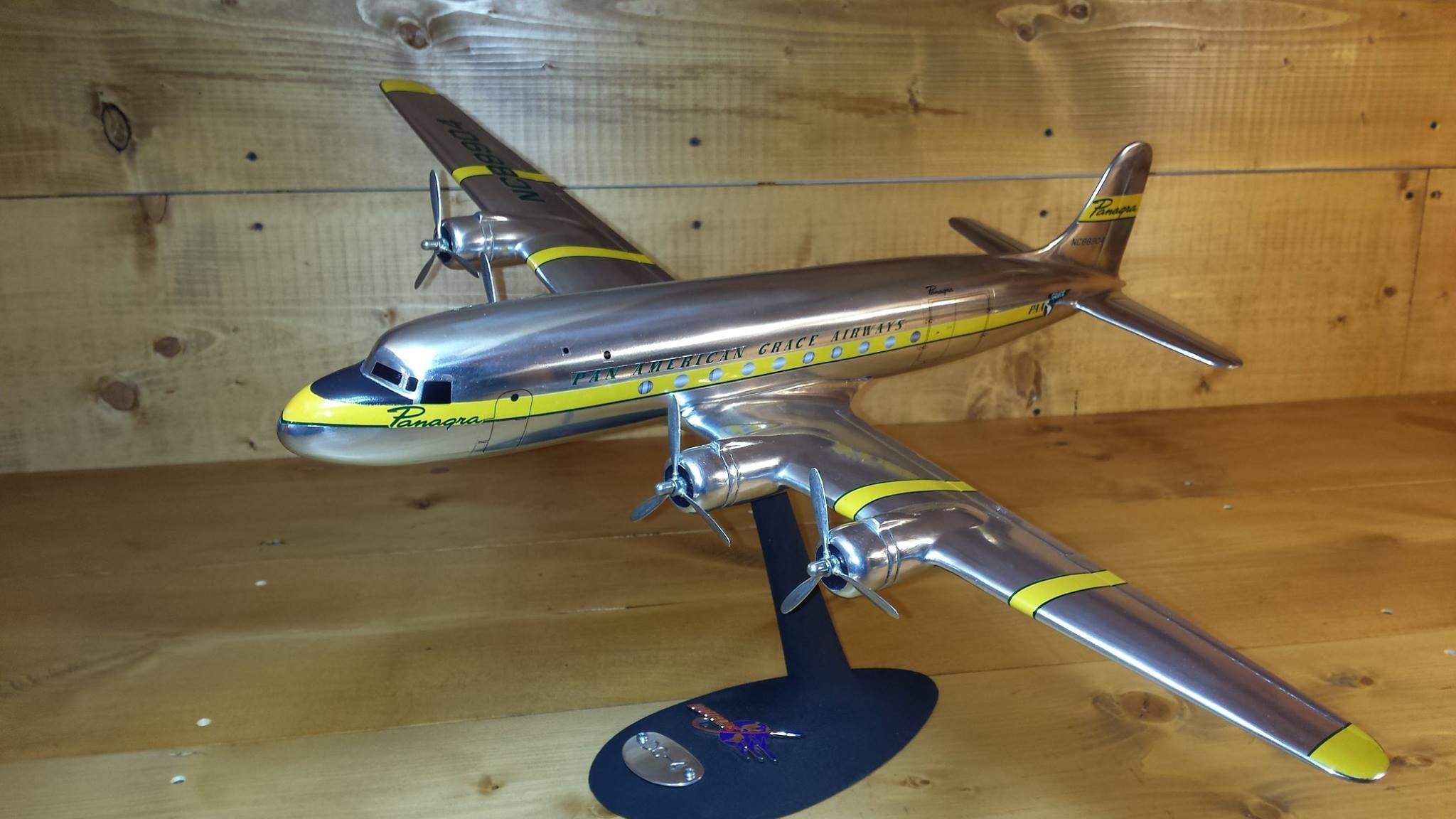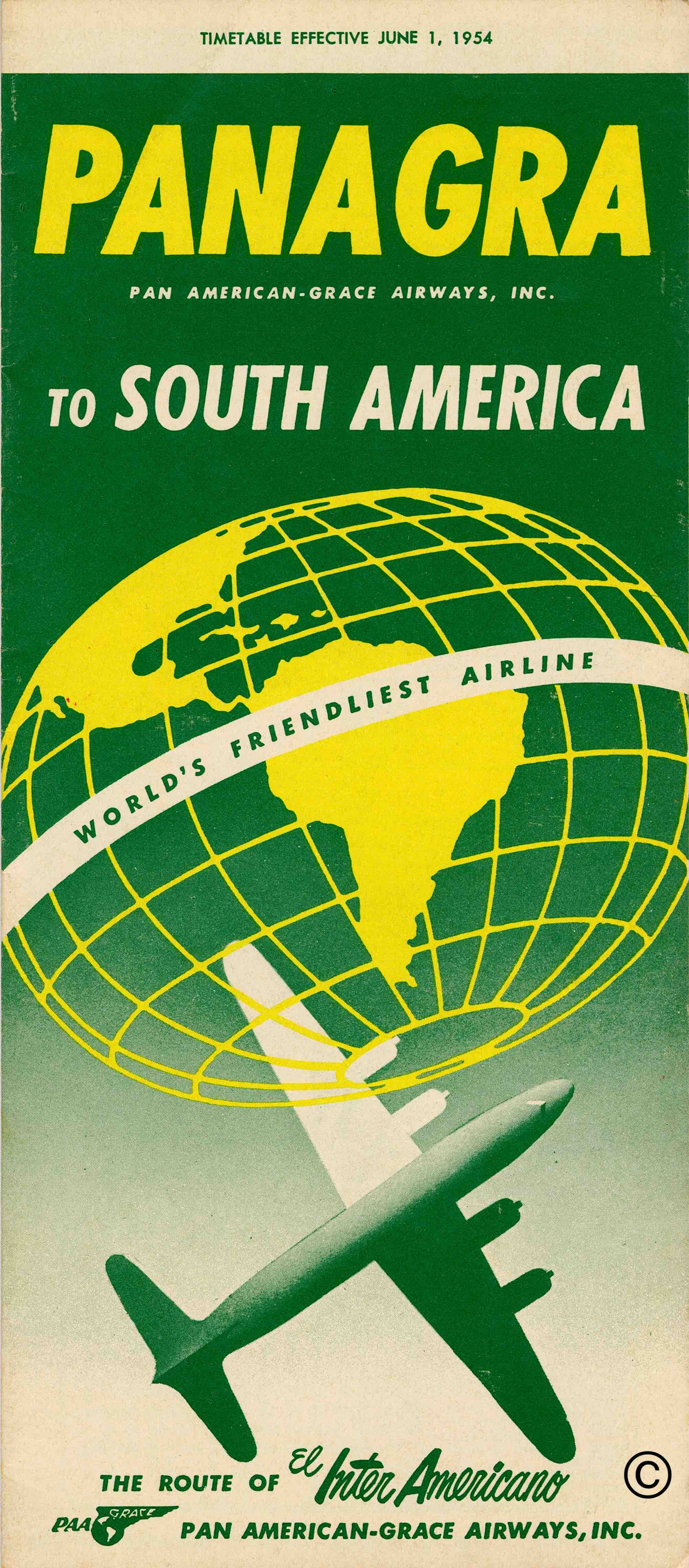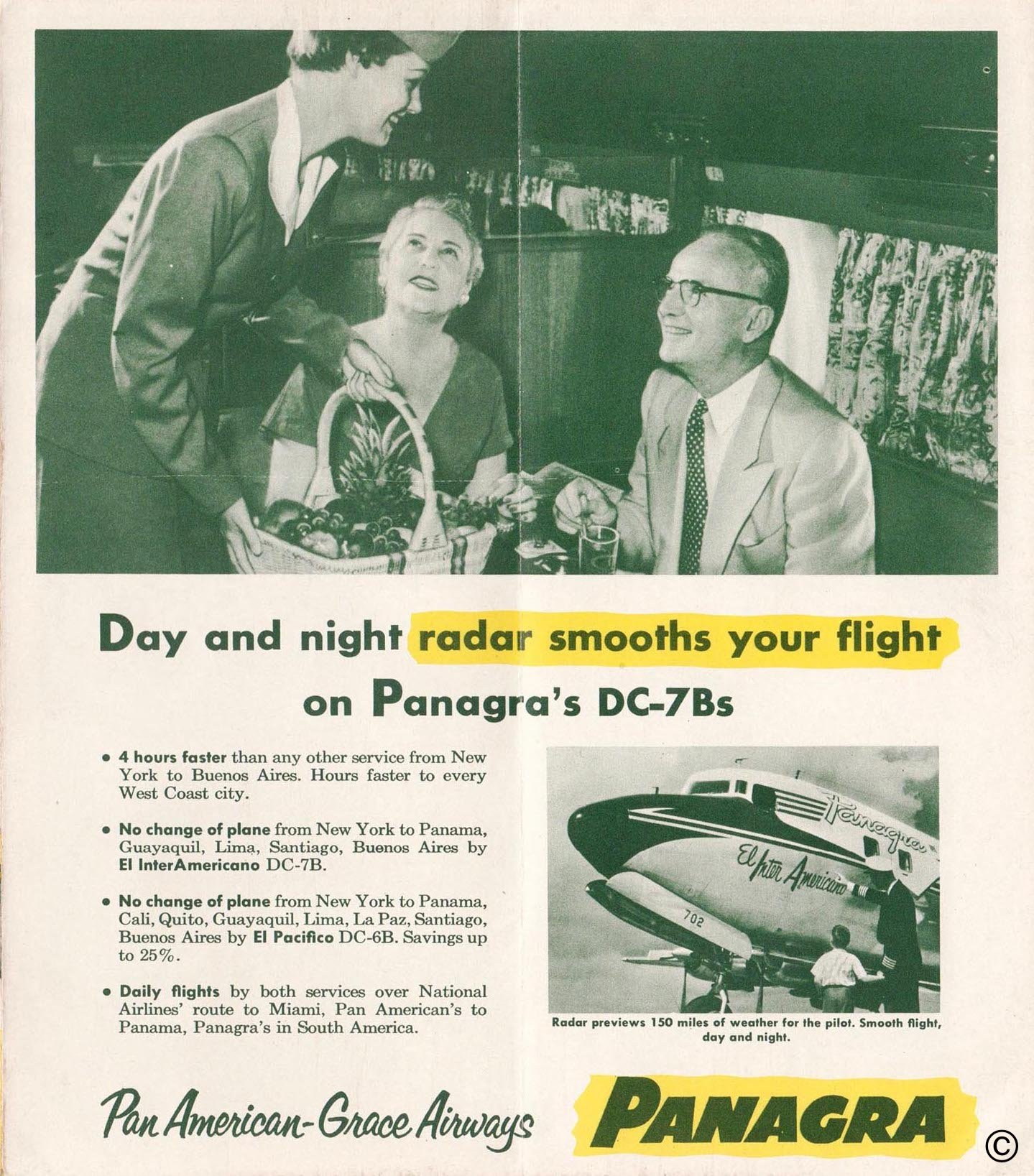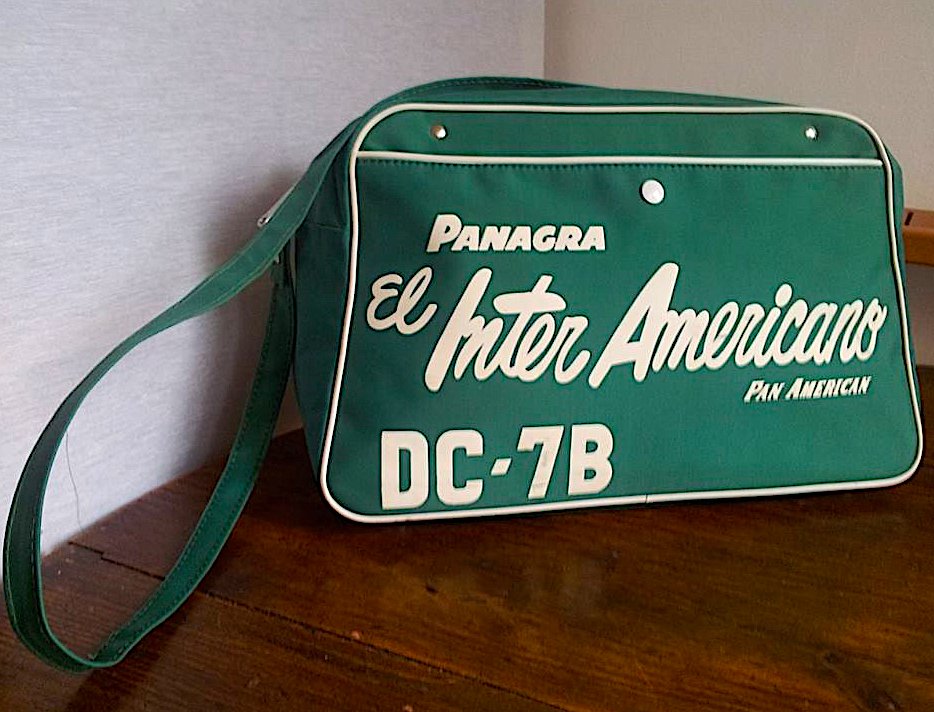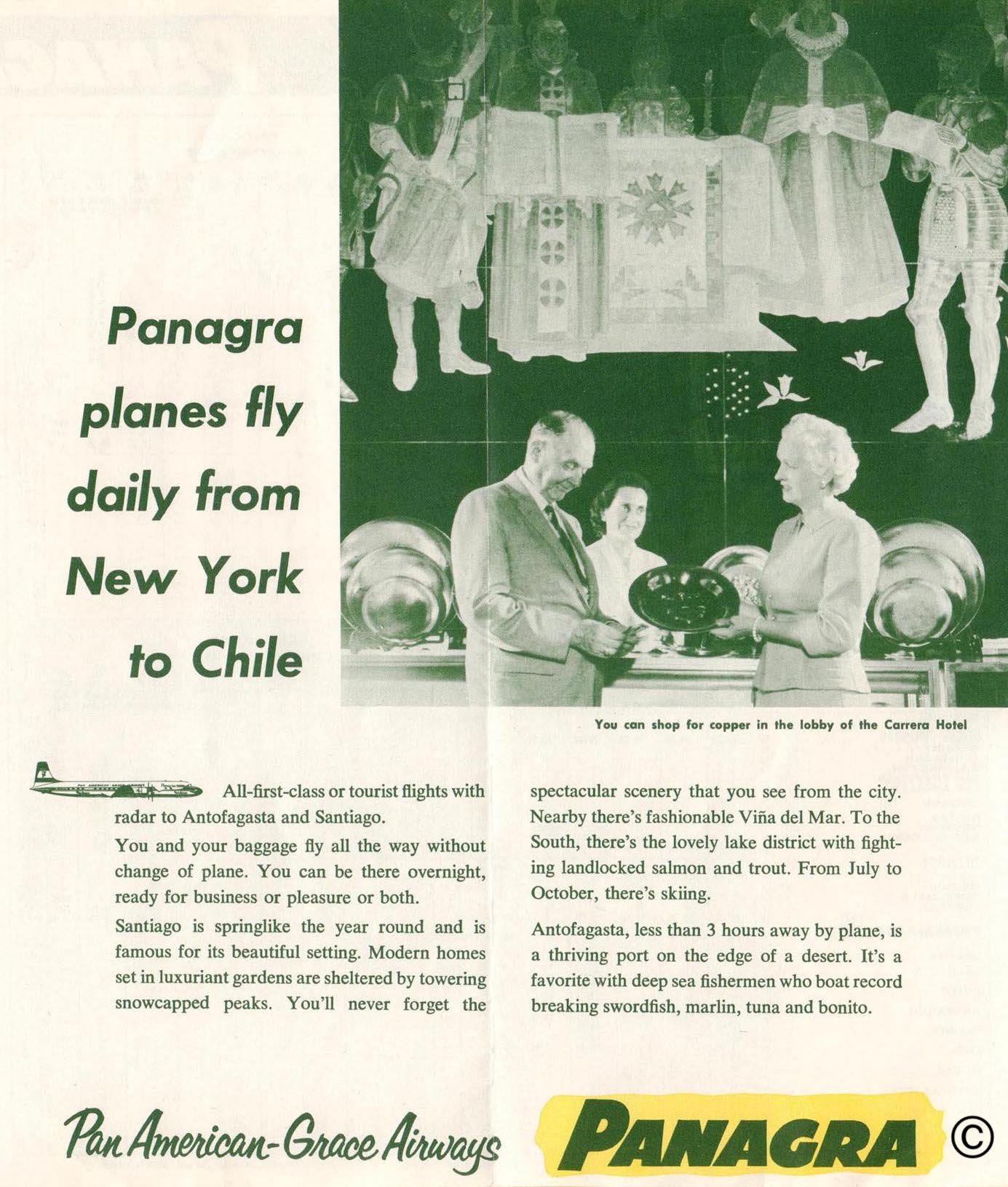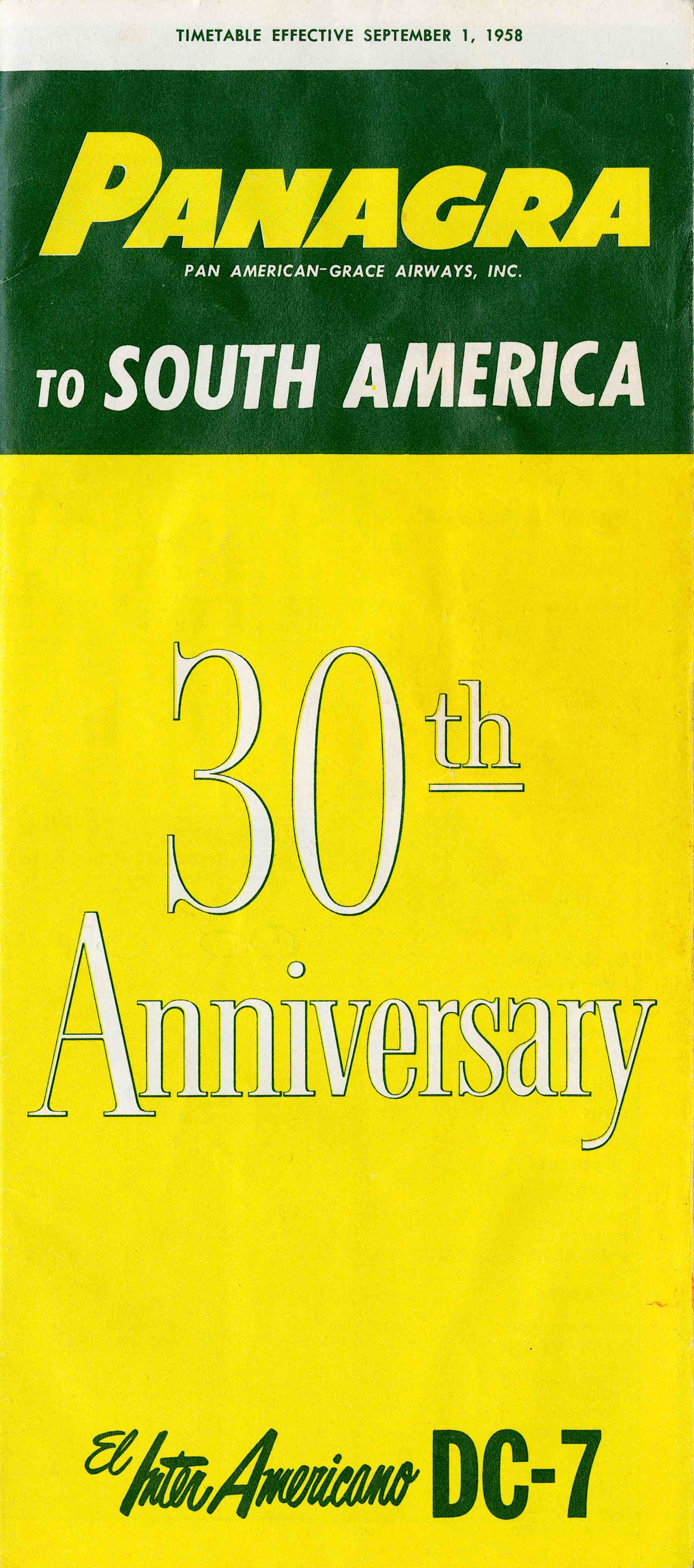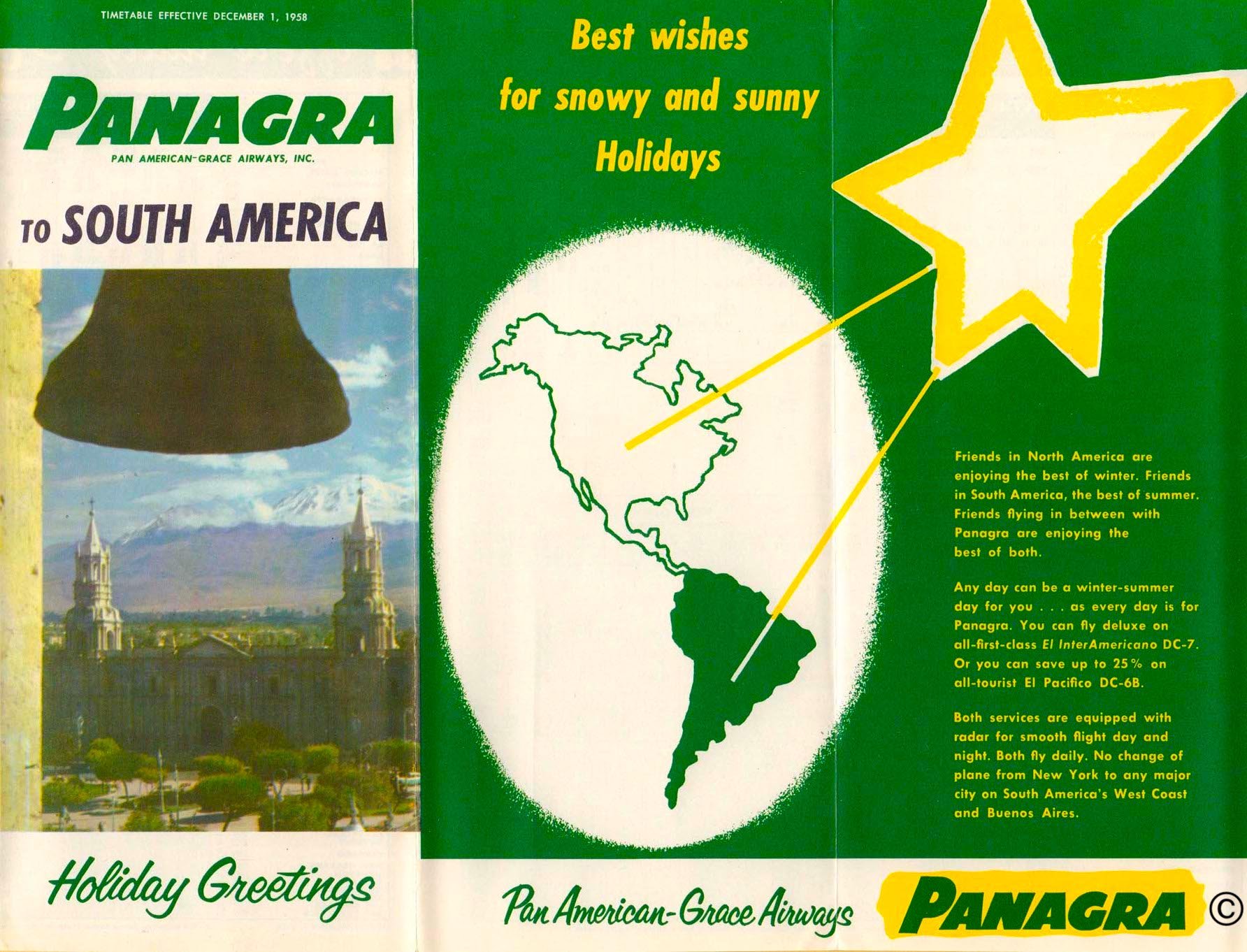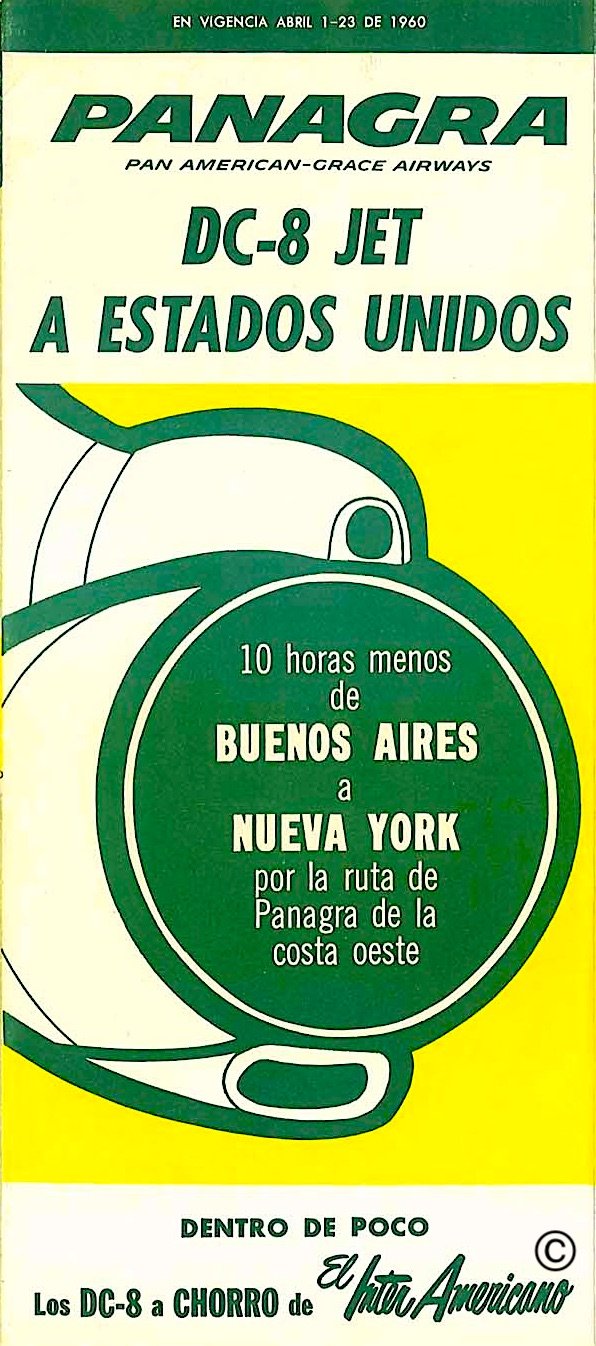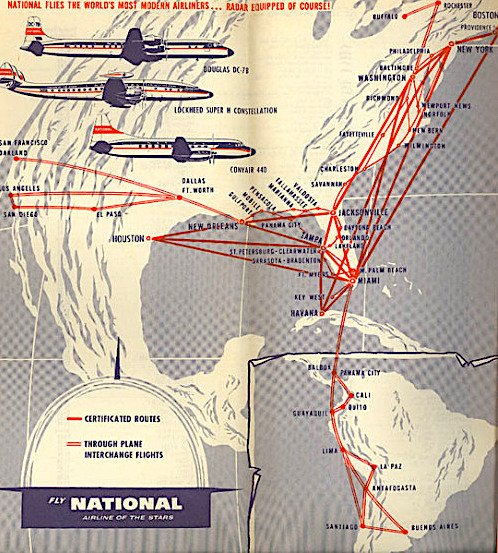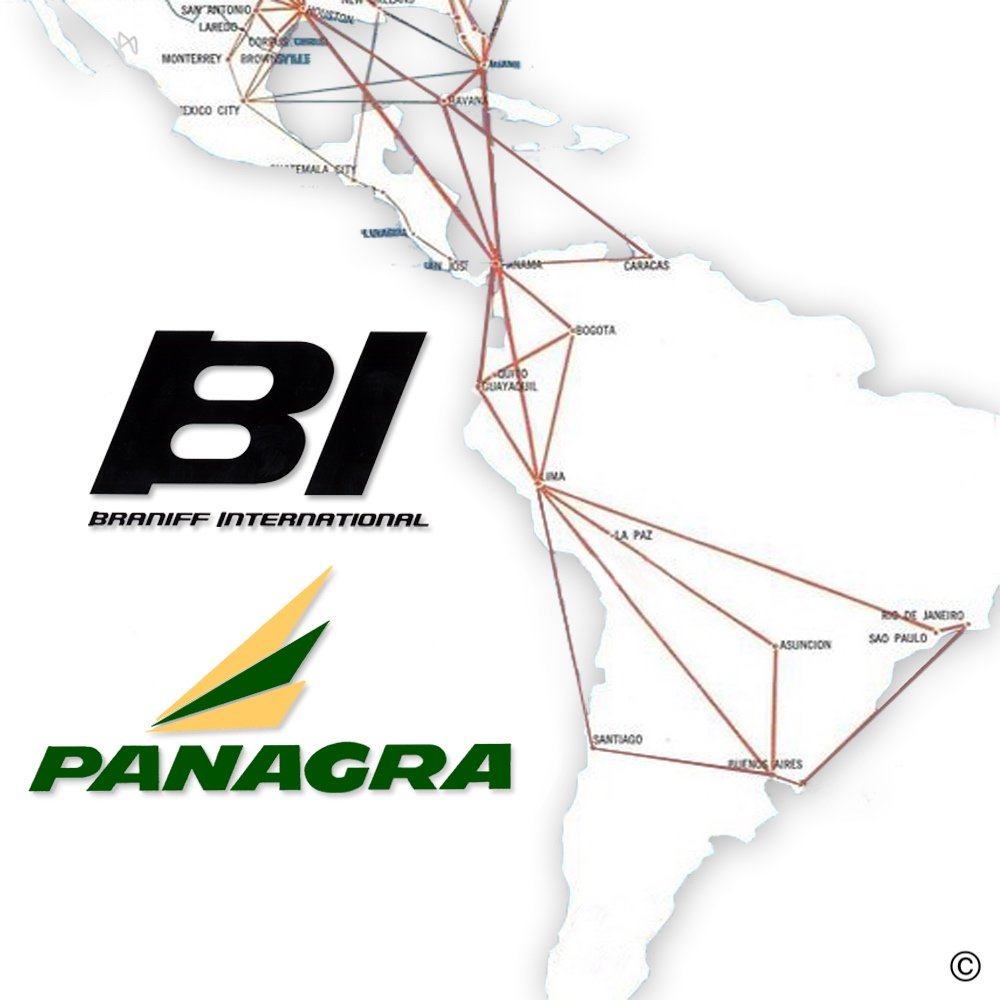Panagra Timeline 1950 to 1967
PAN AMERICAN GRACE AIRWAYS PANAGRA
TIMELINE
1950 TO 1967
1950 to 1959
January 6, 1950
The Civil Aeronautics Authority approves Panagra for Radio Telephone Communication over its La Paz, Bolivia, to Campo Grande, Brazil, and the Sawtooth sector from Santa Cruz, Bolivia, to Concepcion, Paraguay, to San Ignacio, Paraguay, to San Jose, Paraguay, to Robore, Bolivia and Puerto Suarez, Bolivia. With the addition of this sector, Panagra’s entire system is now approved for the use of Radio Telephone Communication
February 8, 1950
All Douglas DC-6 aircraft now feature public address system on board. Flight Attendants can welcome passengers aboard, announce flight times and call attention to various points of interest along the Panagra route
February 19, 1950
A new Douglas DC-6 El Interamericano™ record is established by Panagra Captain Mr. John Henry Miller, while flying from Lima, Peru, to Santiago, Chile, aboard Ship N90878, in only 5 hours and 7 minutes flying time and 5 hours and 15 minutes block to block
February 22, 1950
Panagra Captain Mr. J. S. Shepard sets a new speed record flying Douglas DC-6 El Interamericano registered as N90877 from Lima, Peru, to Panama City Tocumen Airport, Panama, The Canal Zone in 5 hours and 5 minutes flying time and 5 hours and 12 minutes block to block
March 30, 1950
Flight times are greatly reduced between the US Mainland and Bolivia by two hours with the inauguration of Jet Assisted Takeoff or JATO equipped 44-passenger Douglas DC-4 service to La Paz, Bolivia, replacing the Airline’s twin-engine Douglas DC-3 service
May 31, 1950
Panagra celebrates the 15th Anniversary of service to Bolivia
April 26, 1950
The Company announces that it now serves Buenos Aires via the new Ministro Pistarini Airport at Ezeiza, near the capital city. Panagra operated its last service at Moron Airport a day earlier
July 5, 1950
Panagra announces that it will cut fares on its full-size sleeper berths by more than 50 percent on its Douglas DC-6 El Inter-Americano airliners. The new price for lower berth $20 USD and upper is $10 USD, compared to standard price of $45 USD for upper and lower
August 17, 1950
New York World Telegram Newspaper columnist Mr. Ward Morehouse, and his wife Rebecca Franklin, also a columnist, departed Miami, Florida, aboard a Pan American Grace Airways Douglas DC-6 El Inter Americano four-engine airliner for a three week tour around South America. From Miami, he flew to Lima, Peru, and then flew via Panagra DC-4 to La Paz, Bolivia, and then back to Lima, to take the El Inter Americano to Santiago, Chile, where he spent several days. He then flew over the Andes to Buenos Aires, Argentina.
In 1931, Mr. Morehouse made a similar trip that took seventeen and a half days of flying time compared to only two days flying time in 1950. The 1931 trip required ten planes and nine pilots to complete
March 15, 1951
Panagra inaugurates new service via the routes of Panair do Brasil between Lima, Peru, and Rio de Janeiro, Brazil. At Lima, Rio passengers could connect with Panagra Inter Americano to Central and North America
May 4, 1951
Panagra announces that the Airline has flown 12,703,000 Revenue Passenger Miles during the months of March 1951, which is an increase of 31 percent over March 1950, according to Vice President Traffic and Sales John T. Shannon. He also noted that at the current rate, 1951 should be the best traffic recorded in Panagra history
July 26, 1951
Legendary Pan American Grace Airways completes its 20,000th crossing of the equator aboard flying between Panama City, Panama, the Canal Zone, and Lima, Peru
1952
Panagra becomes the first airline to receive the Jack Frye Trophy for the fastest passenger service on a regularly scheduled route operated by a US airline
August 1, 1952
Pan American-Grace Airways announces its new DC-6B Tourist Service will be dubbed El Pacifico, while First Class service will continue on all El Inter Americano DC-6 services
January 8, 1953
US Senator-elect Charles Potter of Michigan, and his wife fly on Panagra during an around South America trip. The couple vacationed for several days in Buenos Aires, Argentina, fished in the lakes of Argentina, visited Santiago, Chile, and Lima, Peru
March 3, 1953
Mr. James H. Stebbins has been elected to the Board of Directors of Pan American Grace Airways. Mr. Stebbins is a vice president at W. R. Grace and Company, having worked for the international industrial and trading concern since 1919
March 6, 1953
Pan American Grace Airways announces that its new Instrument Landing System, known as ILS, is in full operation at Limatambo Airport, at Lima, Peru. The Company purchased and installed the new ILS system via a contract with CORPAC, which is the Peruvian Airport and Commercial Aviation Corporation. With this new system, airliners can continue to land with a cloud ceiling as low as 200 feet AGL and ½ mile visibility. Landing aircraft receive vertical as well as horizontal guidance with bright ground-based lights that guide the aircraft to the runway after it reaches the maximum 200 AGL descent point with ½ mile visibility
March 24, 1953
Company Vice President and Sales Manager Edward G. Bern announces that the company’s policy of reserved seating has been met with great passenger acceptance
April 1, 1953
Company Vice President and Sales Manager Edward G. Bern announces that Panagra’s Load Factors have been high for the first months of 1953. The Airline’s Tourist El Pacifico flights have been producing load factors of 85 percent northbound and 78 percent southbound, averaging 82 percent. The Company expects 1953 to be a banner year
May 25, 1953
Mr. Cyrus S. Collins has been elected as assistant vice president of Panagra, according to Company President Andrew B. Shea. Mr. Collins joined Panagra in 1942, at Lima, Peru, in the Traffic and Operations Departments until 1948 and was then transferred to New York as assistant to the vice president and general manager of the Airline
June 9, 1953
The Company announces that its cargo sales during April 1953 increased by 19 percent compared to the same period in 1952, according to Vice President and Sales Manager Mr. Edward G. Bern. New DC-4 service between Panama City, Panama, The Canal Zone, and Lima, Peru, increased available cargo carrying space, which should increase cargo sales throughout the rest of the year
July 15, 1953
The Company begins a faster schedule between Miami and Colombia and Ecuador. The twice-weekly Douglas DC-4 El Pacifico schedules will now no longer make an overnight stop at Panama City, Panama, and will fly over the route from Miami to Panama, and then Cali, Colombia; Guayaquil, Ecuador and Talara and finally Lima, Peru. The flights from Miami to Cali, will now arrive in only 10 hours and in Quito in 12 hours.
Photo: A stunning Panagra Douglas DC-4 desk model in aluminum made by the famed Douglas Aircraft Company Model Shop in the 1950s. Copyright, World Airline Historical Society
August 15, 1953
In a statement to the Civil Aeronautics Board, Panagra President Andrew B. Shea stated that the elimination of duplication international operations of Braniff International Airways to South America would result in savings of $5 million USD to the Government every year.
Photo: Braniff International Airways is a registered trademark owned by Braniff Airways, Incorporated
September 11, 1953
Company President Andrew B. Shea is awarded the Order of Merit as a Grand Officer by President Manuel A. Odria of Peru. The honor was bestowed for distinguished service on the occasion of Panagra’s 25th Anniversary celebration
August 14, 1953
Panagra announces a luxurious new Fiesta Lounge will be installed in all Douglas DC-6 airliners. The elegantly decorated lounge can seat eight passengers in luxurious comfort
September 17, 1953
Panagra technicians flew a Douglas DC-6 to La Paz, Bolivia, the highest airport in the world, to perform landing and takeoff tests of the water injection systems that it added to the engines of its DC-6 fleet two years earlier. At 13,400 feet mean sea level and featuring a gravel runway, the airport at La Paz requires special care for safe operations, which Panagra has always operated with conservative operating procedures
December 15, 1953
Panagra begins what becomes an annual toy lift to fly thousands of toys donated by US toy manufacturers to needy orphaned and hospitalized children in South America. The toy lift was flown through Christmas 1966
January 20, 1954
South American aviation pioneer Captain Lloyd R. (Dinty) Moore celebrated his 25thyear with Pan American Grace Airways. Captain Moore serves as a pilot instructor at the Company’s Limatambo Base at Lima, Peru, and was one of the Company’s first pilots how inaugurated many of Panagra’s earliest routes. He flew the first airmail from the US Mainland to South America in 1929
February 23, 1954
Pan American Grace Airways marks its 20,000th crossing of the Andes Mountains between Chile and Argentina since its first crossing in 1929. The historical flight was made aboard a massive four-engine Douglas DC-6 in 1954 and a classic Ford Trimotor in 1929.
Photo: The great liberator of Chile, Argentina and Peru, Jose de San Martino, made the first successful crossing of the Andes in January 1817. Crossing with his Army from Mendoza, Argentina, the feat is considered one of the greats of military history. Copyright, National Institute Sanmartiniano
March 8, 1954
Panagra adds an additional tourist flight between Panama and Colombia, Ecuador and Peru to handle the increase in passenger and cargo traffic to these countries. The Company’s Vice President Sales Mr. Edward G. Bern noted that the flights will connect with Pan American World Airways flights at Panama and continuing to Miami, Florida
March 30, 1954
The Company announces that its Revenue Passenger Miles increased an impressive six percent during January and February of 1954. Panagra Vice President Sales Mr. Edward G. Bern made the announcement and noted that the Company generated 23,579,000 RPMs compared to 22,302,000 during the same period in 1953
April 16, 1954
Panagra became the first commercial airline to begin using the latest type of airborne weather radar aboard one of its Douglas DC-6B four-engine airliners used in regularly scheduled operations. The first radar-equipped flight left today from Miami, enroute to Buenos Aires, Argentina, which enables its pilots to see weather 150 miles ahead of the aircraft
May 6, 1954
Pan American Grace Airways President Andrew B. Shea receives the Horatio Alger Award of the American Schools and Colleges Association for his public accomplishments and civic achievement in the American tradition as an example to American youth. Mr. Shea began his career at W. R. Grace and Company in the Mail Room, while studying law at night at Fordham Law School. He became a Director of Panagra in 1947 and assumed the presidency in 1949
June 7, 1954
Douglas DC-3 twin-engine aircraft will be replaced on service between the US Mainland and Panama, Colombia, Ecuador and Peru, with big four-engine Douglas DC-6B aircraft, which establishes the first single-plane service between Miami and cities in Colombia and Ecuador
June 7, 1954
New Douglas DC-6B tourist flights from Miami, Florida, to Lima, Peru, increase from three to five per week
June 11, 1954
Panagra announces that the use of airborne radar to detect and avoid turbulent weather has resulted in greater comforts and safety as well as improved service for Panagra passengers. In April 1954, the Company installed the radar in one of its Douglas DC-6Bs in regular service and after 500 hours of testing under actual weather conditions between the US Mainland and South America
July 10, 1954
Fifteen teenage Junior Ambassadors, between 14 and 17 years of age, depart on a 21-day good will tour to foster good relations and understanding between the United States and Latin America. The American youth departed on a Panagra airliner from Miami, for their tour that takes them through Panama, Colombia, Ecuador, Peru, Bolivia, Chile and Argentina, where they will meet with Presidents and top officials. The tour is sponsored by Pan American Grace Airways
July 30, 1954
The Inter-American Safety Council announces that it is presenting its Aviation Award to Pan American Grace Airways for a perfect safety record during 1953, which marks the 10th consecutive year that the Airline has received this prestigious award. The Company also received the National Safety Council’s annual Aviation Safety Award for this superb safety record
August 3, 1954
The new modern and luxurious Humboldt Hotel Capitol has opened for business in Quito, Ecuador. The new hotel is located in the central business district and features 150 rooms with central heating.
Photo: The magnificent Humboldt Hotel Capitol in 2023, is undergoing a complete full restoration. Copyright, deloguarchitecture.com
August 16, 1954
Panagra announces that its new Douglas DC-7B four-engine airliner fleet will feature the latest airborne weather radar, which can find storm up to 150 miles ahead of the aircraft enabling pilots to avoid turbulent weather. The new Bendix Aviation Corporation X-Band RDR-1 radar will be installed in all five of Panagra’s new DC-7Bs once they begin delivery in 1955
October 7, 1954
The Company announces a new advertising campaign and begins searching for Mr. and Mrs. Mature America. Panagra Vice President Mr. Edward G. Bern explains that the Airline is looking for a typical couple between the ages of 60 and 65 to pose pictures for the new campaign, which includes a tour that begins in October for picture-taking that begins in Miami, Florida, and then proceeds to Quito, Ecuador and then Machu Picchu in Peru and Lake Titicaca and finally Buenos Aires
June 1, 1955
The company announces the that sleek new Douglas DC-7B will begin service in July 1955. However, service did not begin until August 1, 1955
August 1, 1955
Pan American Grace Airways introduces the luxurious radar-equipped Douglas DC-7B, which is billed as America’s newest, finest and fastest commercial airliner. Each new DC-7B represents a $2 million USD per unit investment and its speed can cut flying times by 1 hour 30 minutes throughout the system compared to Douglas DC-6 times.
The DC-7B begins its new service with Panagra between Miami, Florida, and Buenos Aires, Argentina, offering luxurious El Interamericano Fiesta Lounge service. Panagra passengers can now fly from over the route in a fast 16 hours and 15 minutes. The big Douglas cruises at 365 miles-per-hour and can fly 2,950 miles nonstop. The aircraft can fly from Miami to Lima, nonstop
September 1, 1956
Panagra’s new Douglas DC-7B El Inter Americano four-engine airliners now feature safety seeking all-weather radar systems on board
September 20, 1956
Mr. Edward L. Farrell, Jr., is elected Vice President of Pan American-Grace Airways. Mr. Farrell is currently special assistant to Company President Andrew B. Shea and elected to the Board of Directors in December 1955
November 22, to 24, 1956
A special reunion is held in Lima, Peru, for the first Peruvian flight attendants or hostesses to fly for a US airline Panagra. This is the first reunion for the pioneering hostesses since they began flying for Panagra in July 1946
December 14, 1956
Forsaking Rudolph the Red Nosed Reindeer for a luxurious Panagra Douglas DC-6 four-engine airliner, Santa Claus travels to South America to distribute thousands of toys, donated by Ideal Toy Corporation, to underprivileged children. Santa Claus will become Papa Noel for his jaunt through five countries in South America.
Photo: Panagra’s parent company, Pan American World Airways, featured Santa Claus during a photoshoot with a company Douglas DC-4 Clipper. Copyright, Pan American World Airways, Inc.
January 7, 1957
Mr. Cyrus S. Collins is appointed vice president of Sales and Traffic for Pan American-Grace according to Company President Andrew B. Shea. Mr. Collins joined Panagra in 1942 in the Traffic Department at Lima, Peru, and has held an assistance vice president title since 1953
January 22, 1957
Pan American Grace Airways, introduces the first “Gourmet Tour Around South America,” that promises not only to excite the palate but also increase waistlines between two continents. The tour departs Dallas, Texas, on March 2, 1957
February 12, 1957
The Company announces that its air cargo traffic has increased by a remarkable 51 percent compared to 1956, which reflects an increase in trade and commerce between the Americas
June 12, 1957
Pan American Grace Airways President Andrew B. Shea was conferred the honorary degree of Doctor of Laws by Fordham University. Cardinal Spellman cited that Mr. Shea, who is also an executive vice president and director of W. R. Grace and Company, as representing “the highest ideals of an American businessman.” Mr. Shea was a graduate of Fordham Law School, class of 1924
June 13, 1957
Panagra releases the results of a survey it conducted that indicates changing passenger patterns between the US Mainland and South America. According to the survey, the number of travelers flying to South America for pleasure travel had increased significantly. At one time, business travelers outnumbered leisure travelers 4 to 1. Within the past six months, 52 percent of US passengers flew to South America for business purposes, while 35 percent traveled there for leisure
June 28, 1957
Pan American-Grace Airways announces that the Airline has crossed the Andes 25,000 times. The Company made its 25,000th crossing on Friday afternoon flying from Buenos Aires, Argentina, to Santiago, Chile, aboard a Douglas DC-7B with 58 passengers and a crew of five commanded by Captain Donald MacArthur of Coral Gables, Florida.
Panagra’s first trans-Andean flight was flown on October 12, 1929, using a Ford Trimotor airliner. Captain Warren B. Smith holds the record with the most crossings of the Andes by a single pilot having flown 1680 trips
July 7, 1957
Pan American Grace Airways will begin the first regularly scheduled single-plane all-cargo service between the US Mainland and west coast of South America, using four-engine Douglas DC-4 aircraft
September 4, 1957
Mr. James T. Scholtz is elected assistant vice president of Panagra and Mr. James K. Butler is appointed as regional manager of South America, according to Vice President and General Manager Mr. Douglas Campbell
November 18, 1957
Pan American Grace Airways Board of Directors appoints two new officers according to President Andrew B. Shea. Ms. Gail M. Oxley is appointed as secretary of the corporation and Mr. Ramon de Murias as assistant vice president
November 20, 1957
Panagra announces it will install a network of Very High-Frequency Omni-Directional Radio Range stations, known as VOR, throughout Argentina. The Argentina Ministry of Aeronautics has signed an agreement with Pan American Grace to purchase, install and maintain by the US flag carrier, seven VORs manufactured by Wilcox Electric, Inc. In addition, Panagra will train necessary technical personal in the United States
January 1, 1958
New excursion fares for groups of eight or more persons traveling together in South America that will cut as much as 30 percent from regular fares is announced by Panagra and Pan American World Airways
January 6, 1958
Panagra introduces a new 30-day package tour that features six days in Rio de Janeiro, the Mardi Gras capital of the world. Passengers will enjoy the masked balls and the parades and revelry of the amazing Carnival event
January 8, 1958
“How to See South America,” is a new folder listing the package tours and their costs offered by Pan American Grace Airways
March 25, 1958
The “Thru the Lens Tour” organized by top photographer Eric L. Ergenbright in conjunction with Panagra will travel to areas virtually untouched in Panama, Colombia, Ecuador, Peru and Bolivia beginning on June 30, 1958 through August 11, 1958. The 43-day tour will feature cameras specifically focused on the primitive Indian tribes in the five South American countries
September 1, 1958
The company’s 30th Anniversary Celebration was marked by a special timetable cover dated September 1, 1958
September 13, 1958
Pan American Grace Airways, Inc., celebrates its 30th year of service on September 13, 1958. The Company marks the event by honoring the continents it serves with a special “Salute to the Americas” held at Rockefeller Plaza and hosted by Panagra President Andrew B. Shea
December 1, 1958
Panagra begins using colorful photographs on its timetables including this Happy Holidays greeting from The World’s Friendliest Airline
1960 to 1967
May 3, 1960
Pan American Grace Airways inaugurates the first Douglas DC-8-31 jet service between the US Mainland and Central and South America via the Panagra/National Airlines/Pan American World Airways interchange service flying from New York Idlewild Airport to Miami, Florida; Panama City, Panama the Canal Zone; Lima, Peru and Buenos Aires, Argentina
January 10, 1961
Panagra announces that it has extended stays by 15 additional days for passengers traveling on excursion fares on trips around South America. The new extension raises total days for travel from 30 to 45 and is available to one or more passengers traveling between points in the continental United States, Canada, Cuba, Dominican Republic, Haiti, Jamaica, Mexico, Puerto Rico, Buenos Aires, Argentina; Montevideo, Uruguay and Santiago, Chile
August 30, 1961
Pan American Grace Airways increases Douglas DC-8-31 jet service to Buenos Aires, Argentina, to six times each week and reduce its Douglas DC-7 propeller service to once each week. In addition, all DC-7 flights to Santiago, Chile, will be replaced with jet service with five flights each week reducing travel time between New York and Santiago to only 13 hours
August 31, 1961
Panagra inaugurates new Douglas DC-8-31 jet service to Guayaquil, Ecuador, and announces that flying time from the US Mainland to Ecuador will cut flying time nearly in half. The new service operates from New York City to Guayaquil with intermediate stops at Miami, Florida, and Panama City, Panama the Canal Zone. Panagra already serves Lima and Buenos Aires with new Douglas DC-8-31 jet service
September 6, 1961
Pan American Grace Airways wins the Chris Award for its new film about South America, titled “Continent of Contrasts.” The Film Council of Greater Columbus has awarded Panagra its top prize in the travel category for 1961
November 14, 1961
The Company introduces new jet service with lower economy fares that have caused tour business to South America to increase substantially. Panagra reports that purchase of tour packages has increased by 95-percent, which can be tailored to fit most any vacation budget or schedule
January 1962
Pan American Grace Airways, Inc., and National Airlines, Inc., form Simultrain, which is a sophisticated system of providing pilot training on the ground for the Douglas DC-8 jet. In Florida, students from both airlines as well as other contracting companies learn to fly using a DC-8 simulator
January 10, 1962
Panagra introduces a new book for passengers that contain the do’s and don’ts and other tips for traveling in South America in this handy 128-page pocket-sized manual titled “How to Get the Most Out of Your Trip to South America.”
March 28, 1962
Panagra receives a Safety Award for its superb adherence to air carrier safety standards. The Inter-American Safety Council awarded Panagra the honor for having flown 2,616,847,000 passenger miles during the last 18 years without an accident.
Photo: Pan American Grace Airways longtime ad agency, the renowned J. Walther Thompson, created this ad that touts Panagra’s frequent jet service to Buenos Aires, Argentina. Copyright, Braniff Airways, Incorporated
October 21, 1962
Every spring, brings spectacular bullfights to the 200-year old Plaza de Acho in Lima, Peru. From October 21, 1962 and continuing every Sunday through November 18, 1962, with a special corrida on November 1, 1962, seven internationally known toreros will test their skill against the bravest bulls from top breeding ranches of Spain and Peru
September 4, 1963
Peru marks the 35th Anniversary of United States air transportation in South America and the start of Pan American Grace Airways by affixing a commemorative cachet on all outbound air mail
September 6, 1963
Panagra petitions the Civil Aeronautics Board to begin operating passenger and all-cargo jet service between Boston, New York, Baltimore, Washington DC and Miami, in the New York-Florida Service Investigation Route Case. The Company also asked to cut fares over the new routes by 21 percent
1964
Panagra becomes the first airline to offer Douglas DC-8 Intercontinental Jet service at Quito, Ecuador
1964
Pan American Grace Airways becomes the first airline to land a four-engine jet at El Alto Airport, serving La Paz, Bolivia, which is the highest commercial airport in the world
December 1965
Pan American World Airways, Inc., W. R. Grace and Company and Braniff Airways, Incorporated, agree for Braniff to purchase Pan American Grace Airways, Inc., through Braniff’s purchase of W. R. Grace’s 50 percent ownership of Panagra and Pan American’s 50 percent ownership of Panagra. Under the agreement, Braniff will pay $30 million USD for the purchase of Panagra with $15 million USD going to both W. R. Grace and Pan American
1966
New nonstop jet service is inaugurated between New York and Lima, Peru
1966
Panagra begins service from San Francisco then Los Angeles to Lima, Peru, with Douglas DC-8-31 Intercontinental Jets
1966
Pan American Grace Airways inaugurates the first nonstop jet service between Quito, Ecuador and Lima, Peru.
Photo: This magnificent 1/25 scale Douglas DC-8-31 Intercontinental Jet Cutaway Model features and clear plexiglass fuselage with highly detailed interior. Panagra Vice President Edward G. Bern, center, is meeting with Douglas Aircraft officials in 1959.
Today, this model is curated in the Braniff International Heritage Archives, in Dallas, Texas, which also houses Panagra’s corporate records and historical memorabilia and papers. In 2023, the model underwent a full restoration, Copyright, Braniff Airways, Incorporated
March 17, 1966
Braniff International announced that an agreement had been reached with New York City-based Pan American World Airways to purchase the fabled airline's ownership of Pan American-Grace Airways, Inc. After nearly 13 years of negotiation, Pan Am accepted Braniff's offer of a cash payment of $15 million USD for Pan Am’s 50-percent ownership in Panagra
June 1, 1966
Pan American Grace Airways, Pan American World Airways and National Airlines, inaugurate the first direct jet service between New York City and Cali, Colombia, once every week using Panagra DC-8-31 four-engine jetliners, which reduces the time to travel between the two cities to only 8 hours and 25 minutes
June 1, 1966
Panagra provides air transportation for passenger, mail and cargo over a 4251-mile route network throughout Panama, Colombia, Ecuador, Peru, Bolivia, Chile and Argentina, using a fleet of modern Douglas airliners, including the fast and efficient Douglas DC-8-31 Intercontinental Jet, which links Buenos Aires, Santiago, Antofagasta, La Paz, Lima, Guayaquil, Quito, Cali and Panama City with the US Mainland Gateways of Miami and New York City
September 11, 1966
Panagra becomes the first US intercontinental airline to operate an all jet fleet as the last propeller-driven Douglas DC-7B is retired
October 19, 1966
United States President Lyndon Baines Johnson approves the merger of Braniff Airways, Incorporated, and Pan American Grace Airways, Inc.
Photo: Braniff Flight Attendants Carleen Reichmann, left, and Sue Pedler, are shown Panagra’s first aircraft, the famed Fairchild FC-2, by Panagra Captain Frederick T. Sterling. While the aircraft had been donated to the Smithsonian in 1949, it was part of an exhibit on the Mall at Washington DC, on April 1, 1966. Copyright, Braniff Airways, Incorporated
December 28, 1966
The US Civil Aeronautics Board approves the sale of Pan American Grace Airways, Inc., to Braniff Airways, Incorporated.
Photo: Braniff International President Harding L. Lawrence, left and Panagra President Andrew B. Shea meet at the steps of a Panagra DC-8-31 Intercontinental Jet at Lima, Peru, in March 1966. Mr. Lawrence toured Panagra’s facilities in Latin America once the agreement had been formulated for merger between the two companies. Copyright, Braniff Airways, Incorporated
January 15, 1967
Braniff International Executive Vice President Charles Edward Acker presents a check for $15 million USD to W. R. Grace and Company Assistant General Counsel Walter Morris, which signals the historic finalization of the merger between the two carriers.
Photo: Panagra’s former headquarters at Lima, Peru, soon after the merger in February 1967. Copyright, Braniff Airways, Incorporated
January 18, 1967
The $30 million Braniff Airways, Incorporated, purchase of Pan American Grace Airways, Inc., purchase agreement is completed
January 19, 1967
Harding L. Lawrence, Braniff’s Chairman, announces that Braniff Airways will merge with Panagra effective February 1, 1967, during a press conference in New York City.
Photo: A Panagra flight attendant models her uniform one last time at Plaza San Martin in Lima, Peru, just prior to the merger in February 1967. Copyright, Braniff Airways, Incorporated
February 1, 1967
Pan American Grace Airways, Inc., merges with Dallas-based Braniff Airways, Incorporated, with Braniff as the surviving carrier. Panagra ceases to exist as its last flight, a Douglas DC-8-31 Intercontinental Jet registered as N8275H arrives into Lima, Peru
Braniff paid a nominal amount for Panagra, which included a fleet of DC-8-31 jets along with prepaid deposits of $27 million on 5 ordered DC-8-62 Intercontinental Jets that were delivered to Braniff beginning in the summer of 1967. At the time of the 1964, merger negotiation, Panagra had not ordered the five Super 62 jetliners. The new negotiation figure of $30 million USD did include the new jets and their handsome deposits, whereas the 1964 figure of $22 million USD included the DC-8-31s and an aging fleet of propeller aircraft.
Braniff International Chairman of the Board of Directors Harding L. Lawrence held a press conference in New York City to announce the purchase of Panagra. "This is perhaps the most significant development in air transportation between North and South America, since the advent of the jet aircraft," Lawrence said. He further stated, "On February 1, Braniff will merge the Latin American operations of Panagra with Braniff and begin the first combined service under the Braniff International name."
New service that resulted from combining the two carriers, featured the first through-flights from San Francisco and Los Angeles to Lima and La Paz and Lima and Santiago that eliminated the need for change of planes at Panama City. New nonstop service was also inaugurated between Santiago, Chile and Miami, Florida, for the first time.
Braniff acquired seven used aircraft and five new aircraft orders as a result of the merger. The Panagra fleet included two Douglas DC-7B's, one Douglas DC-8-55F (Freighter) Jet Trader, which was leased from Douglas in 1966, four Douglas DC-8-31s, and orders for five Douglas DC-8-62 Intercontinental Jets.
